The rapid but unpredictable rise of AI is making it harder than ever for companies in broadcast & media to predict their future skills requirements – but that shouldn’t be a reason to fall into despondency, discovers David Davies.
The consensus view is that broadcast & media has been facing an increasingly serious skills crisis for several years now. In particular, the combination of limited access to training in some technical disciplines and the retirement of a generation of senior engineers has yielded a ‘perfect storm’ of challenges that will afflict broadcasters for the next decade at least.

To that mix one can now add the rapid but deeply unpredictable rise of AI. The likely impact on some roles – for instance, basic editing and the more repetitive aspects of localisation – isn’t too hard to predict. But with new applications emerging all the time, and meaningful regulation only beginning to emerge (led by the EU, which has just reached provision agreement on new legislation) – let alone gain parity with the pace of innovation – taking the long view is increasingly challenging.
Read more: AI and Ethics: The Defining Point of Content Creation
Inevitably, it’s a state of affairs that has serious consequences for skills & recruitment. “It is very challenging; it’s not only the technologies that are changing and rapidly evolving, but also the resources [that underpin the industry],” said Lelde Ardava, Sales and Account Manager at linear TV SaaS platform developer Veset, although like many others interviewed for this piece she ultimately struck an optimistic tone: “There is a fear that AI will take away people’s jobs, but it’s not going to happen. Instead, we need to think more positively and focus on the future, and what the benefits of [the new technologies] can be.”
‘Constant change’
In fact, the ’12 years and counting’ history of Veset – which was acquired by PLAY Japan in February 2023 – provides an ideal prism through which to view many of the primary shifts in broadcast technology recruitment. As Ardava noted, “there is constant change, [and that can actually be appealing] in terms of companies retaining staff; for example, I have spoken to people in the industry who have been in the same job for eight or ten years, but aren’t looking for another because it’s so interesting where they are now.”

In terms of the factors increasingly determining job descriptions, Ardava identified no fewer than eight that she thinks are having a profound impact across the board. Several of them – the ongoing shift from hardware to software, and the increased requirement for IT and cloud expertise – require no explanation at this point. But others are more fluid and therefore more challenging for companies to address.
For example, “the rapid pace of technological change in cloud-based automation means that learning cannot be static,” said Ardava. “Consequently, recruitment should focus on individuals who are not only skilled, but also demonstrate a willingness and ability to continuously learn and adapt to new technologies and workflows.” The same goes for the ever-increasing amount of data being generated by broadcast systems: “There’s a growing need for professionals who can analyse this data and make informed decisions – blending know-how with strategic thinking.”

Many of the recruitment trends may seem technologically-driven – including the refinement of some existing engineering roles and the creation of new positions such as digital workflow specialists and cloud security analysts – but that doesn’t mean the need for ‘soft skills’ is diminished; indeed, there is an argument to be made for them being more critical than ever, especially in highly collaborative and/or geographically dispersed working environments.
Highlighting Veset’s specific line of business, Ardava remarked that “despite the technical nature of cloud playout solutions, soft skills like communication, teamwork and problem-solving remain vital. Therefore, the ability to collaborate effectively in a tech-driven environment and communicate complex technical concepts to non-technical team members is increasingly important.”
Training issues & trusting AI
For global video solutions provider Accedo, the rise of automation has created both challenges – for instance, identifying sufficient engineers with the necessary programming skills – and opportunities to “make more processes effective and efficient, including through the use of AI,” said Pernilla Wranéus, who is the company’s VP Global Head of People and Culture.
Like many observers, she agrees that satisfying the full range of skill-sets has become more problematic in recent times: “We do want the most skilled people, and competition [in the industry] has increased; at the same time, we also work to transform our current employees through the learning of new skills, so that can be quite demanding, too.”
Accordingly, the benefit of explicitly defined career pathways and skills frameworks has become more evident. To which end, “we have just launched a new job architecture […] in order for people to have a more transparent view on how to advance their career within the company, including what comes with that and the kind of training you need to do to attain a certain position, We are rolling out the tools and processes for that at the moment,” said Wranéus, who alluded to “micro-learning” mechanisms including dedicated video content and knowledge-sharing sessions.
Pondering the broader impact of AI on broadcast production – including in areas such as content approval and assessment – Wranéus’ Accedo colleague Daniel Eneström, who is Head of Engineering EMEA & LatAm, identified a crucial point of transition involving AI that must be causing plenty of sleepless nights across M&E.

“One of the biggest hurdles with AI is that of trust,” he said. “Not only trusting that the outcome is of good quality, but also [ensuring] that there are proofing processes in place to make sure that content produced by Generative AI is actually accurate and reliable. [Consequently] broadcasters are currently trying to figure out [how to implement] AI in a way that makes sense and improves that efficiency, while keeping the human element to ensure quality remains paramount.”
At the same time, added Eneström, “broadcasters need to ensure they retain the same level of creativity – something AI cannot replace, at least not in the short term. While it will drastically speed up many of the processes within the media workflow, we will always need a highly skilled professional ensuring no errors are made and that the industry continues to generate fresh and creative ideas.”
The potential of ‘utilitarian’ AI
Striking a balance between creativity and automation, and the specific potential the latter brings for lightening the (human) load surrounding the less creative aspects of production is also on the mind of Michael Cioni. And no wonder because he is Founder & CEO of Strada, which was announced recently as “the world’s first AI-enabled cloud platform for content creators”.
“When it comes to applications for media and entertainment, I view AI in two categories: generative and utilitarian,” he said. “While generative AI garners the largest amount of attention, I believe the most practical form of AI for creatives is found in automating tasks that are traditionally non-creative in nature. Tasks such as transferring batches of files, synchronising audio to video, logging or tagging elements within captured footage, transcribing and translating language, and converting video. These tasks are slow and tedious and introduce delays before creatives can begin the creative editing steps of a project.”
The recruitment debate should arguably be framed around speeding up tasks with utilitarian AI – “not replacing the people who perform them”. Cioni added: “Virtually every form of new technology changes and/or eliminates some jobs in pursuit of introducing advantages or improvements to a workforce. AI is the latest example of emerging technology that will impact roles in the arts, but its goal is to make things better for the creative by increasing creative control. As utilitarian tasks become automated, roles associated with those will have the opportunity to be freed up to contribute in new ways or take advantage of more time to improve the quality of a project.”
Talent-wise, it’s bound to be those who “lean into tech early” who are best-positioned for the future. “New talent should research, test, and explore all the terms and tools affiliated with AI technology. Likewise, established businesses ought to be looking for talent that demonstrates a strong interest and experience in using AI to help improve the storytelling process. They are the ones to hire.”
AI’s place in a ‘long chain of historic events’
Erik Otto, CEO of broadcast compliance monitoring specialist Mediaproxy, made the case for AI being the latest in a long line of developments dating back to the Industrial Revolution that have tended to prompt an alarmist response in some quarters. “It’s been a sort of ‘progressive threat’ in human history that whenever we have technological improvements, we immediately ring the bell and want to start painting a [bleak] scenario that suggests we’re going to be replaced by machines. I mean, it’s quite old that theme!” he exclaims. “And of course, AI is now sort of placing itself into a long chain of historic events that have essentially spurred on the same sentiment.”

It therefore follows that Otto inclines towards a more optimistic view on AI, highlighting its potential for various processes in the broadcast chain, such as routing and keeping track of different content variants. Noting the recent explosion in the number of OTT streams and FAST channels, he observed: “Humans are not capable of monitoring that many moving pieces of colour movement and audio concurrently.”
Like the other contributors to this article, Otto also acknowledges a difficulty sourcing high-level candidates for recruitment. He indicated that a continuing dearth of dedicated training in the company’s home country of Australia has been a factor; so, too, has been inaccurate but enduring perceptions of what it’s like to work in broadcast and media engineering these days.
Ironically, it could actually be the reinvigoration of some distinctly old-school skills that enables the industry to keep pace with its phenomenal rate of innovation during the next few years. “You need to have the ability to learn and I do think that’s starting to become very difficult,” said Otto. “You have newer generations to deal with who are effectively becoming more and more isolated, which is also having an impact on their communication skills.”
Gen Z data confirms the sometimes-dramatic shift in content consumption and engagement habits when compared even to the previous generation. But despite the challenges, Otto does not subscribe to a “doom & gloom idea about it being ‘the end of work’”.
“I really don’t think so,” he asserted. “There are enough bright young boys and girls around, and they’re going to grow up, get some experience, and work out what’s right and wrong. And some of them will want to go ahead and work in this industry and end up making a really significant contribution.”
Read more: Regulating AI: Can new legislation impose order before it’s too late?
























No comments yet